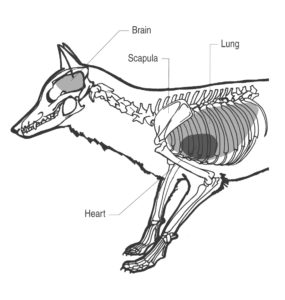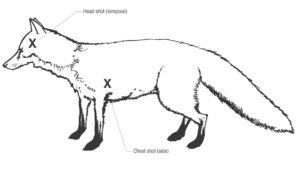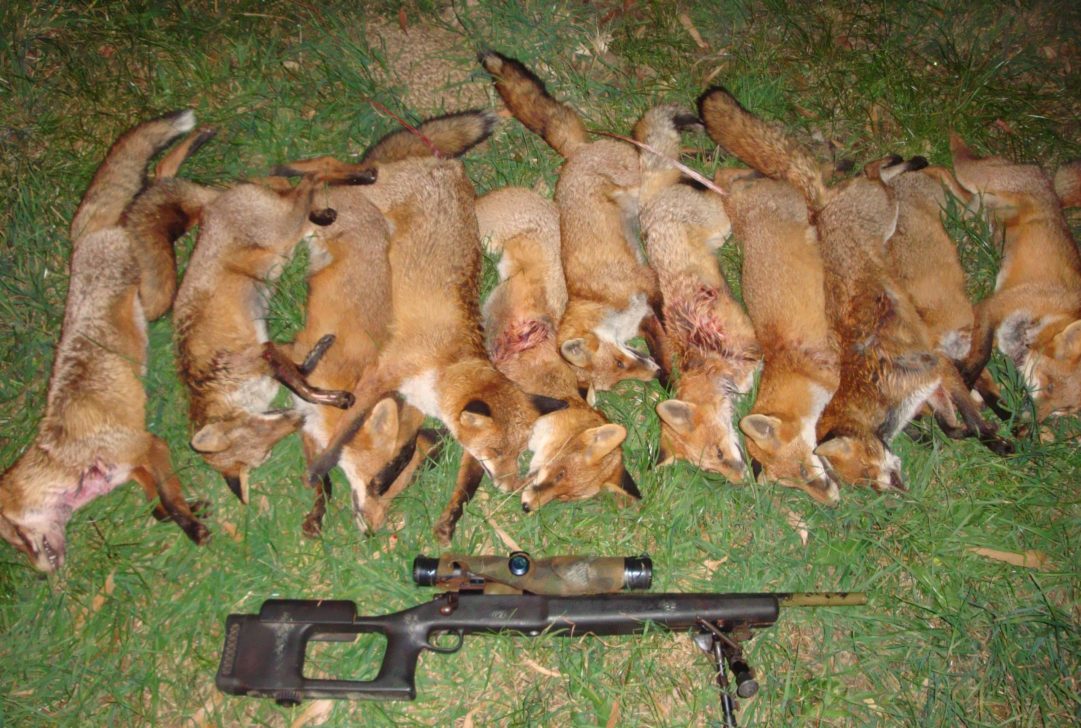Endorsed by the Invasive Plants and Animals Committee 2016 with minor updates September 2017.
DOWNLOAD AS PRINTABLE PDF
Background
The introduced European red fox (Vulpes vulpes) has a significant impact on native fauna and agricultural production. Fox control methods include lethal baiting, trapping, shooting, den fumigation, den destruction and exclusion fencing.
Shooting of foxes is undertaken by government vertebrate pest control officers, landholders and professional or experienced licensed shooters. Although shooting may reduce the local number of foxes or problem animals, it is labour intensive and is not effective as a general fox control method. Shooting is usually done at night from a vehicle with the aid of a spotlight, but can also be conducted during the day. Fox drives (‘battues’) using a line of beaters to flush foxes into a line of guns are occasionally used in rural areas.
Shooting is a humane method of destroying foxes when it is carried out by experienced, skilled and responsible shooters; the animal can be clearly seen and is within range; and the correct firearm, ammunition and shot placement is used.
This National Standard Operating Procedure (NATSOP) is a guide only; it does not replace or override the legislation that applies in the relevant state or territory jurisdiction. The NATSOP should only be used subject to the applicable legal requirements (including OH&S) operating in the relevant jurisdiction.
Application
- Shooting should only be used in a strategic manner as part of a co-ordinated program designed to
achieve sustained effective control.
- Shooting is often used prior to lambing season and as an adjunct to other control methods. It is time-consuming and labour intensive and therefore an inefficient method for large-scale fox control in Australia.
- Although shooting can result in a localised reduction in fox numbers, it is ineffective in significantly reducing fox populations, particularly over the longer-term.
- Young, inexperienced foxes, which are easily lured into the shooters range, are more likely to be killed by shooting. To compensate for this bias, the breeding and survival of remaining animals is enhanced. Also, dispersal of foxes from the area decreases whilst the rate of fox immigration from other areas increases.
- Shooting is not suitable where dense cover is available for foxes or in the vicinity of human habitation.
- Shooting of foxes should only be performed by skilled operators who have the necessary experience with firearms and who hold the appropriate licences and accreditation. Storage and transportation of firearms and ammunition must comply with relevant legislative requirements.
Animal welfare considerations
Impact on target animals
- The humaneness of shooting as a control technique depends almost entirely on the skill and judgement of the shooter. If properly carried out, it is one of the most humane methods of destroying foxes. On the other hand, if inexpertly carried out, shooting can result in wounding which may cause considerable pain and suffering.
- Shooting must be conducted with the appropriate firearms and ammunition and in a manner which aims to cause immediate insensibility and painless death.
- When shooting an animal, it must be clearly visible and able to be killed with a single shot.
- Only head (brain) or chest (heart-lung) shots must be used. Shots to the head are preferred over chest shots as they are more likely to cause instantaneous loss of consciousness. Chest shots do not render the animals instantaneously insensible and are likely to result in a higher incidence of wounding. Shooting at other parts of the body is unacceptable.
- The shooter must be certain that each animal is dead before another is targeted.
- Wounded foxes must be located and dispatched as quickly and humanely as possible with a second shot preferably directed to the head. If left, wounded animals can escape and suffer from pain and the disabling effects of the injury.
- If lactating vixens are shot, efforts should be made to find dependent cubs and kill them quickly and humanely by either shooting (with a single shot to the brain) or by fumigation of the den with carbon monoxide (refer to NATSOP-FOX004 National Standard Operating Procedure: Fumigation of fox dens with carbon monoxide).
Impact on non-target animals
- Shooting is relatively target specific and does not usually impact on other species. However, there is always a risk of injuring or killing non-target animals, including livestock, if shots are taken at movement, colour, shape, sound or, when spotlighting, eye reflection (‘eye shine’). Only shoot at the target animal once it has been positively identified and never shoot over the top of hills or ridges as other animals or people may be out of sight beyond the hill in the danger zone.
- Shooting should be used with caution around lambing paddocks as it may disturb the lambing flock and cause mismothering. Also avoid paddocks containing sensitive livestock e.g. horses, deer. They are easily frightened by spotlights and gunshots and may injure themselves by running
into fences and other obstacles.
Health and safety considerations
- Firearms are hazardous. All people should stand well behind the shooter when an animal is being shot. The line of fire must be chosen to prevent accidents or injury from stray bullets or ricochets.
- Shooting from a vehicle is potentially dangerous. An agreed safety procedure between the shooter and others in the vehicle must be in place to ensure that people do not enter the field of fire or disturb the taking of a shot.
- Firearm users must strictly observe all relevant safety guidelines relating to firearm ownership, possession and use.
- Firearms must be securely stored in a compartment that meets state legal requirements. Ammunition must be stored in a locked container separate from firearms.
- Adequate hearing protection should be worn by the shooter and others in the immediate vicinity of the shooter. Repeated exposure to firearm noise can cause irreversible hearing damage.
- Safety glasses are recommended to protect eyes from gases, metal fragments and other particles.
- Warm, comfortable clothing and stout footwear is recommended, especially when shooting at night
- Care must be taken when handling fox carcasses as they may carry diseases such as hydatidosis and sarcoptic mange that can affect humans and other animals. A fox with obvious mange should only be handled while wearing gloves. Routinely wash hands after handling all fox carcasses.
Equipment required
- Firearms and ammunition
- Small bore, high velocity, centre fire rifles fitted
with a telescopic sight are preferred e.g. .22-250, .22 Hornet, .222 Remington, .223 or .243 Winchester. Hollow-point or soft-nosed ammunition should always be used.
- Rimfire weapons with lower muzzle energy are not recommended because of the greater risk of non-lethal wounding.
- 12-gauge shotguns with heavy shot sizes of No. 2, SSG, BB or AAA may be effective, but only up to a distance of 20 m from the target animal.
- The accuracy and precision of firearms should be tested against inanimate targets prior to the commencement of any shooting operation.
Other equipment
- if shooting at night, a handheld spotlight (at least 100 watt), or a helmet or headband mounted 12 volt (35 watt) spotlight
- fox whistle (for making artificial rabbit distress calls), if desired
- first aid kit
- lockable firearm box
- lockable ammunition box
- personal protective equipment (hearing and eye protection)
Procedures
Shooting at night
- Most shooting of foxes is done at night from a vehicle with the aid of a spotlight. This method relies on the ability of the shooter to approach the animal until it is within shooting range. Some shooters try and lure animals into range by using whistles that produce artificial rabbit distress calls.
- Foxes must NOT be shot from a moving vehicle or other moving platform as this can significantly detract from the shooters’ accuracy. Ensure you are in a firm, safe and stable position before taking a shot.
- It is recommended that during daylight hours shooters familiarise themselves with the terrain they are to cover. Take note of potential hazards and also any landmarks that may help with navigation.
- Shooting over the top of hills or ridges produces unacceptable risk. Be aware that the spotlight only illuminates a small portion of the danger zone and only a fraction of the projectile’s range.
- When illuminated by the spotlight, foxes have an extremely bright eye reflection or shine ranging from pale yellow in juveniles to a golden yellow in mature foxes.
- If you are using a spotlight and have identified a fox, do not fire unless you are sure it will be killed. Foxes learn very quickly and if previously frightened may not face a light again. Also, when using fox whistles be sure to get a successful shot so that the fox will not learn to associate whistles with danger.
Shooting in the day
- Foxes are mostly active at night and at dawn and dusk, so shooting during the day is less effective than shooting at night with a spotlight.
- Daylight drives or ‘battues’ are sometimes effective and are common in some rural areas.
These involve the use of unarmed beaters, often with dogs, to drive foxes into a line of people waiting with firearms. Many foxes, including wary adults, can be taken by this method but it requires the use of many people and only small areas can be covered.
- If dogs are used during battues to flush foxes out from vegetation or dens, they must be adequately controlled to prevent them from attacking foxes.
Dogs should only be trained to drive foxes from cover, not to capture or attack them. For further information on the use of dogs refer to GEN002 The care and management of dogs used for pest animal control.
- Fox drives or battues are not selective, so there is a risk of encountering other animals, including pet cats, which can be mistaken for a fox and shot. Also, if dogs are used, they may pursue and sometimes catch non-target animals. Capture of foxes or non-target species by dogs is unacceptable on animal welfare grounds.
Target animal and point of aim
- The objective is to fire at the closest range practicable in order to reduce the risk of non-lethal wounding. Accuracy with a single shot is important to achieve an immediate and, therefore, humane death.
- A fox should only be shot at when:
– it can be clearly seen and recognised
– it is within the effective range of the firearm and ammunition being used
– a humane kill is probable. If in doubt, do NOT shoot.
- The shooter must aim either at the head, to destroy the major centres at the back of the brain near the spinal cord or, at the chest, to destroy the heart, lungs and great blood vessels. This can be achieved by one of the following methods (see Diagram 1):
Head Shot (this is the preferred point of aim)
Frontal position (front view)
The firearm is aimed at a point midway between the level of the eyes and the base of the ears, but slightly off to one side so as to miss the bony ridge that runs down the middle of the skull. The aim should be slightly across the centreline of the skull and towards the spine.
Temporal position (side view)
The firearm is aimed horizontally at the side of the head at a point midway between the eye and the base of the ear.
Chest Shot
Side view
The animal is shot from the side so that the bullet enters the chest at a point behind the foreleg slightly above and immediately behind the elbow joint.
- When using a rifle, the target animal must be stationary and within a range that permits accurate placement of the shot. Shots to the head are preferred over chest shots.
- When using a shotgun, the target animal may be stationary or mobile, but must be no more than 20 metres from the shooter. The pattern of shot should be centred on the head or chest. It is essential that the distance to the target animal is accurately judged. To achieve adequate penetration of shot, the animal must be in range. It is recommended that shooters practice estimating distances before a shooting operation.
- The target animal should be checked to ensure it is dead before moving on to the next animal. Death of shot animals should always be confirmed by observing the following:
– absence of rhythmic, respiratory movements
absence of eye protection reflex (corneal reflex) or ‘blink’
– a fixed, glazed expression in the eyes
– loss of colour in mucous membranes (become mottled and pale without refill after pressure is applied).
- If death cannot be verified, a second shot to the head should be taken immediately.

Head shot (frontal)

Side view (skeleton)

Recommended shot placements for foxes Note: Head shots (temporal or frontal) should be used for shooting foxes caught in traps.
References
- American Veterinary Medical Association (2001). 2000 Report of the AVMA Panel on Euthanasia. Journal of the American Veterinary Medical Association 218:669-696.
- Bloomfield T (2001). Foxes: Integrated fox control. Landcare Notes. Department of Primary Industries, Victoria.
- Bucknell R (2001) Foxing with lamp and rifle. Foxearth Publishing, Essex, United Kingdom.
- The British Association for Shooting and Conservation (2010). Code of Practice for Lamping (Night Shooting).
- Gregory N (2003). Assessing the humaneness of pest control methods. In: Solutions for achieving humane vertebrate pest control. Proceedings of the 2003 RSPCA Australia Scientific Seminar, Telstra Theatre, Australian War Memorial, Canberra 25 February, 2003. Pp 65-84. Royal Society for the Prevention of Cruelty to Animals Australia, Deakin West, ACT.
- Mawson P (1991). Ethics, animal welfare and operational guidelines for the humane shooting of pest animals. Agriculture Protection Board of Western Australia Infonote.
- NSW Agriculture, NSW National Parks & Wildlife Service, Rural Lands Protection Boards, NSW Police (2003). Feral Animal Aerial Shooting Team (FAAST) Management and Training System.
- Saunders G, Coman B, Kinnear J and Braysher M (1995). Managing vertebrate pests: foxes. Australian Government Publishing Service, Canberra.
- Smith G (1999). A guide to hunting and shooting in Australia. Regency Publishing, South Australia.
- UFAW (1976). Humane destruction of unwanted animals. Universities Federation for Animal Welfare, Potters Bar, England.
The Centre for Invasive Species Solutions manages these documents on behalf of the Environment and Invasives Committee (EIC). The authors of these documents have taken care to validate the accuracy of the information at the time of writing. This information has been prepared with care but it is provided “as is”, without warranty of any kind, to the extent permitted by law.
Connect with government
It is important to contact the relevant federal, state or territory government agency before undertaking fox control to ensure you have the right permits in place
Connect














